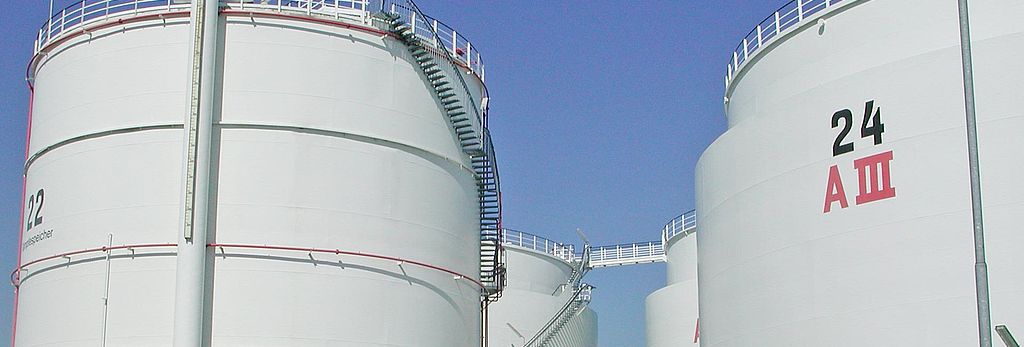
Tank storage & tank terminals
What is tank storage logistics? What are tank terminals?
Tank terminals are facilities where petroleum products, chemicals, gases, biofuels, SynFuels and other liquid products – i.e. liquid or gaseous substances – can be stored and handled. Tank terminals consist of a number of individual tanks, generally above ground, that are usually cylindrical.
Materials used in tank storage
Tanks can be made of different materials. The materials most commonly used in tank storage are steel, concrete in combination with plastic, fiberglass-reinforced plastic, nylon, and polyethylene. Oil is usually stored in vertical cylindrical tanks made of steel. The appropriate type of construction and materials for storing these products is defined by DIN standards. Beyond this, the respective federal state building regulations based on the Construction Products Act, and all applicable fire protection regulations must also be observed when constructing a tank terminal.
Tank storage design and equipment
Apart from materials and shape, tanks also vary in their design and equipment. The most common types of tank are fixed-roof tanks with and without an internal floating roof, external floating-roof tanks, cup tanks, and cryogenic tanks. The type of construction used also depends on the properties of the products to be stored in them. Cryogenic tanks, for example, are used for materials that have to be stored in liquefied form at very low temperatures. At ambient temperature, these products would be gaseous.
The paint used on the tanks also has an effect on the emission values of a given tank type; the goal in tank storage is to reduce emissions wherever possible. Crude oil tanks are also often equipped with stirrers at the bottom tank shell, or mixer jets, to be able to homogenize and mix the oil.
Access types in tank storage
As tank terminals are transshipment centers for raw materials and products, they have various options available for loading and unloading, as well as onward transport. The most common facilities are jetties, pipeline connections, rail cars and tank truck platforms. As sea routes via vessels or barges and pipeline are usually the preferred method of transport for many products, tank terminals are often located along waterways.
Security of supply
In addition to serving as transshipment centers, tank terminals also make an important contribution to securing supply to countries that have no crude oil reserves of their own. Since 1978, the Petroleum Stockholding Association (EBV - Erdölbevorratungsverband) has been responsible for this security of supply in Germany. It organizes the storage of stocks of at least 90 days’ consumption of crude oil and petroleum products such as gasoline (petrol), diesel fuel, heating oil and jet fuel. Membership in the EBV, and contributions to its funding, are mandatory for all companies that produce these products in Germany or import them into the country. For the European Union, corresponding requirements can be found in the “Council Directive 2009/119/EC of 14 September 2009 imposing an obligation on Member States to maintain minimum stocks of crude oil and/or petroleum products.”
Health, safety, security & environment in the field of tank storage
Health, safety, security & environment (HSSE) is an especially important issue at tank terminals. Fire prevention in particular is an important aspect in the construction and operation of a tank terminal, due to the high flammability and explosiveness of many of the stored products. This is one reason why tanks normally have to be equipped with water or foam connections. Another important safety aspect in tank storage is to prevent contamination of soil or drinking water in the event that a tank is damaged – which is why tanks are either executed as cup tanks or as conventional tanks in liquid-tight containment chambers. The volume of these containment chambers is designed in such a way – using earthworks or concrete and steel catch basins – that they must be able to hold the entire contents of the tank plus 10% additional capacity. In addition, the stored products are accurately classified and grouped into dangerous goods classes, so that quick and efficient action can be taken in acute situations. For this reason, the aim is to have the shortest possible pipeline paths between the tanks and the associated loading facilities when planning the spatial arrangement of the tanks.
The Mabanaft business unit Supply, Infrastructure & Trading covers international trading and the supply, infrastructure and logistics activities, including a network of tank terminals.
Mabanaft buiness unit Supply, Infrastructure & Trading
Tank storage solutions of Oiltanking Deutschland
Status: December 2015
All information subject to change. Errors and omissions excepted.

